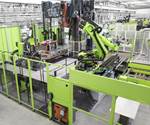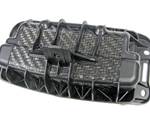Engel Combines Lightweighting and Composite Technologies in Bicycle Handlebar
Engel’s fluidmelt, glass-fiber-filled polyamide 6 and unidirectional carbon-fiber tapes combine to create a highly reinforced yet lightweight handlebar in a mass-production process.
Injection molding machine and automation supplier Engel is exhibiting for the first time at Eurobike, presenting a complete production cell for manufacturing of an innovative bicycle handlebar for Canyon Bicycles. Molded on a tiebarless Engel victory 180 from a glass fiber-reinforced polyamide 6, the handelbar’s core is hollowed out by Engel’s fluidmelt technology, while four unidirectional (UD) carbon-fiber tapes are overmolded for additional strength in specific areas of the part. DOMO Chemicals supplied the polyamide and the carbon-fiber UD tapes for the part, while the mold was built by Simoldes.
The fully automated production process requires no postprocessing steps, while significantly reducing the COâ‚‚ footprint through targeted material use and full recyclability. Engel says the result is a lightweight molded composite structure that matches the performance of aluminum with a production time of around one minute.
Engel’s fluidmelt process displaces the molten core of the component during molding, pushing the material into an overflow cavity or back into the plasticizing unit with water or nitrogen to hollow out thick sections of a part.

The process enables advanced functions such as the integration of additional components in a single process step. Source: Engel
An Engel spokesperson told Plastics Technology that at the Eurobike booth nitrogen will be used, but in full production water would be more efficient.
Prior to injection, the easix 6-axis articulated arm robot that removes the part inserts the four UD carbon-fiber tapes, which are bonded during the injection molding process. Engel says this combination enables high rigidity and structural stability, despite low wall thicknesses that result from the hollow cross section. The spokesperson said two of the carbon-fiber tapes, which do not require preheating or forming, would be visible from below the handlebar, but the other two on the top side of the part are inside the hollow structure and not visible.

A cross section reveals the hollowing out of the handlebar core by Engel’s fluidmelt process. Source: Engel
Paul Zwicklhuber, technology manager for lightweight solutions at Engel, says this combination of technologies reduces weight while offering high stability and design freedom, including the ability to integrate cable routing or display mounts directly into a single production process, lowering production costs and carbon footprint.
Engel says the expanded mold space of the Engel victory’s tiebarless design enables the use of large and complex molds, making it ideal for demanding geometries such as the bicycle handlebar. The machine series’ wide-platen option features enlarged mounting platens, providing an additional 100 mm (approximately 4”) in width compared to standard models. If higher clamping force isn’t required, this design eliminates the need to invest in a larger machine.
Related Content
-
Prices Bottom Out for Volume Resins?
Flat-to-down trajectory underway for fourth quarter for commodity resins.
-
ICIS Launches: Ask ICIS Generative AI Commodities Assistant
Said to be the first of its kind, this AI assistant will enhance access to ICIS’ intelligence and insights for the energy and chemical markets.
-
The Fantasy and Reality of Raw Material Shelf Life: Part 1
Is a two-year-old hygroscopic resin kept in its original packaging still useful? Let’s try to answer that question and clear up some misconceptions.







